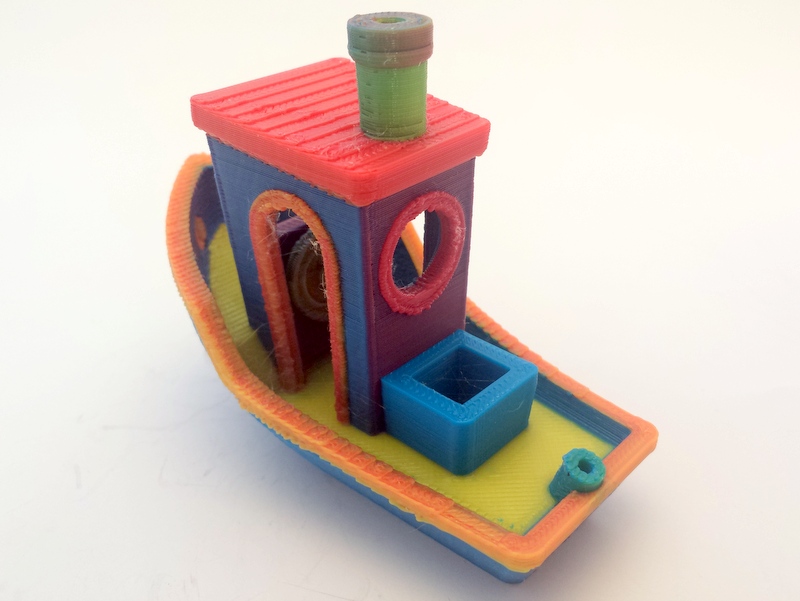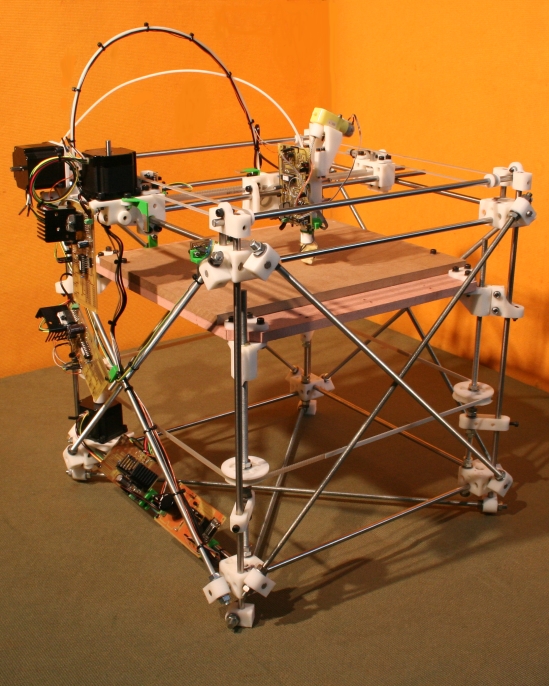|
Xinchejian
Xinchejian (Mandarin: 新车间; pinyin: xīn chē jiān) is the first hackerspace in China. It was founded in 2010 by David Li, Ricky Ng-Adam, and Min Lin Hsieh in Shanghai, inspired by hackerspaces in the West and the Shanzhai culture of China. Xinchejian is registered as a company, but is run as a non-profit organization, and managed by volunteers. Mission According to Xinchejian's about page, "Xīnchējiān is a non-profit organization, its mission is to support, create and promote physical computing, open source hardware and Internet of Things... Our long-term goal is to spread the concept and philosophy across China and inspire Hackerspaces in every large city from east to west." Xinjechian has been noted as China's first hackerspace, and as a place for innovation and collaboration, in a country also known for its strong internet censorship. Membership Xinchejian encourages people to become a member and contribute to the maker community in Shanghai. Non-members are wel ... [...More Info...] [...Related Items...] OR: [Wikipedia] [Google] [Baidu] |
Hackerspaces
A hackerspace (also referred to as a hacklab, hackspace, or makerspace) is a community-operated, often "not for profit" (501(c)(3) organization, 501(c)(3) in the United States), workspace where people with common interests, such as computers, machining, technology, science, digital art, or electronic art, can meeting, meet, Socialization, socialize, and Collaboration, collaborate. Hackerspaces are comparable to other community-operated spaces with similar aims and mechanisms such as Fab Lab (fabrication laboratory), Fab Lab, men's sheds, and commercial "for-profit" companies. History In 2006 Paul Böhm came up with a fundraising strategy based on the Street Performer Protocol to build Metalab in Vienna, Austria, and became its founding director. In 2007 he and others started Hackerspaces.org, a wiki-based website that maintains a list of many hackerspaces and documents patterns on how to start and run them. , the community list included 1967 hackerspaces with 1199 active sites a ... [...More Info...] [...Related Items...] OR: [Wikipedia] [Google] [Baidu] |
Gold Coast Techspace
The Gold Coast Techspace is a Hackerspace and Makerspace focusing on electronics, computer programming, and 3D printing. It is currently located at the Mudgeeraba Old Post Office, Mudgeeraba, Gold Coast, Queensland, Australia. Gold Coast Techspace is a central component of the Gold Coast startup ecosystem and has a sister relationship with Xinchejian, a Hackerspace in Shanghai, China. History The space was started by a group of local technologists, Lucas Brandt, Steven Dalton & Nick Byrne in 2011. Shortly after acquiring their first location in Johnston St, Southport, Gold Coast Techspace (GCTS), was incorporated as a Queensland Incorporated Association (Non-profit) and has operated this way since. For a while the Gold Coast TechSpace also ran the first coworking space on the Gold Coast – Gold Coast Co-working. As more coworking spaces emerged on the Gold Coast, the GCTS Co-Working space was closed to allow the space to focus on its core activities. Over the years GCTS ... [...More Info...] [...Related Items...] OR: [Wikipedia] [Google] [Baidu] |
Hackerspace
A hackerspace (also referred to as a hacklab, hackspace, or makerspace) is a community-operated, often "not for profit" (501(c)(3) in the United States), workspace where people with common interests, such as computers, machining, technology, science, digital art, or electronic art, can meet, socialize, and collaborate. Hackerspaces are comparable to other community-operated spaces with similar aims and mechanisms such as Fab Lab, men's sheds, and commercial "for-profit" companies. History In 2006 Paul Böhm came up with a fundraising strategy based on the Street Performer Protocol to build Metalab in Vienna, Austria, and became its founding director. In 2007 he and others started Hackerspaces.org, a wiki-based website that maintains a list of many hackerspaces and documents patterns on how to start and run them. , the community list included 1967 hackerspaces with 1199 active sites and 354 planned sites. The advent of crowdfunding and Kickstarter (founded in 2009) has p ... [...More Info...] [...Related Items...] OR: [Wikipedia] [Google] [Baidu] |
Maker Culture
The maker culture is a contemporary subculture representing a technology-based extension of DIY culture that intersects with hardware-oriented parts of hacker culture and revels in the creation of new devices as well as tinkering with existing ones. The maker culture in general supports open-source hardware. Typical interests enjoyed by the maker culture include engineering-oriented pursuits such as electronics, robotics, 3-D printing, and the use of computer numeric control tools, as well as more traditional activities such as metalworking, woodworking, and, mainly, its predecessor, traditional arts and crafts. The subculture stresses a cut-and-paste approach to standardized hobbyist technologies, and encourages cookbook re-use of designs published on websites and maker-oriented publications. There is a strong focus on using and learning practical skills and applying them to reference designs. There is also growing work on equity and the maker culture. Philosophical emphas ... [...More Info...] [...Related Items...] OR: [Wikipedia] [Google] [Baidu] |
Hacker Ethic
The hacker ethic is a philosophy and set of moral values within hacker culture. Practitioners believe that sharing information and data with others is an ethical imperative. The hacker ethic is related to the concept of freedom of information, as well as the political theories of anti-authoritarianism, anarchism, and libertarianism. While some tenets of the hacker ethic were described in other texts like '' Computer Lib/Dream Machines'' (1974) by Ted Nelson, the term ''hacker ethic'' is generally attributed to journalist Steven Levy, who appears to have been the first to document both the philosophy and the founders of the philosophy in his 1984 book titled '' Hackers: Heroes of the Computer Revolution.'' History The hacker ethic originated at the Massachusetts Institute of Technology in the 1950s–1960s. The term "hacker" has long been used there to describe college pranks that MIT students would regularly devise, and was used more generally to describe a project undertake ... [...More Info...] [...Related Items...] OR: [Wikipedia] [Google] [Baidu] |
3D Printing
3D printing, or additive manufacturing, is the construction of a three-dimensional object from a CAD model or a digital 3D model. It can be done in a variety of processes in which material is deposited, joined or solidified under computer control, with the material being added together (such as plastics, liquids or powder grains being fused), typically layer by layer. In the 1980s, 3D printing techniques were considered suitable only for the production of functional or aesthetic prototypes, and a more appropriate term for it at the time was rapid prototyping. , the precision, repeatability, and material range of 3D printing have increased to the point that some 3D printing processes are considered viable as an industrial-production technology; in this context, the term ''additive manufacturing'' can be used synonymously with ''3D printing''. One of the key advantages of 3D printing is the ability to produce very complex shapes or geometries that would be otherwise infeasi ... [...More Info...] [...Related Items...] OR: [Wikipedia] [Google] [Baidu] |
Computer Clubs
A computer is a machine that can be Computer programming, programmed to automatically Execution (computing), carry out sequences of arithmetic or logical operations (''computation''). Modern digital electronic computers can perform generic sets of operations known as Computer program, ''programs'', which enable computers to perform a wide range of tasks. The term computer system may refer to a nominally complete computer that includes the Computer hardware, hardware, operating system, software, and peripheral equipment needed and used for full operation; or to a group of computers that are linked and function together, such as a computer network or computer cluster. A broad range of Programmable logic controller, industrial and Consumer electronics, consumer products use computers as control systems, including simple special-purpose devices like microwave ovens and remote controls, and factory devices like industrial robots. Computers are at the core of general-purpose devices ... [...More Info...] [...Related Items...] OR: [Wikipedia] [Google] [Baidu] |
DIY Culture
"Do it yourself" ("DIY") is the method of building, wikt:modification, modifying, or repairing things by oneself without the direct aid of professionals or certified experts. Academic research has described DIY as behaviors where "individuals use Raw material, raw and semi-raw materials and parts to produce, transform, or reconstruct material possessions, including those drawn from the natural environment (e.g., landscaping)". DIY behavior can be triggered by various motivations previously categorized as market economy, marketplace motivations (economic benefits, lack of product availability, lack of product quality, need for customization), and identity (social science), identity enhancement (Workmanship, craftsmanship, empowerment, community seeking, uniqueness). The term "do-it-yourself" has been associated with consumers since at least 1912 primarily in the domain of home improvement and maintenance activities. The phrase "do it yourself" had come into common usage (in stan ... [...More Info...] [...Related Items...] OR: [Wikipedia] [Google] [Baidu] |
Open Design
The open-design movement involves the development of physical products, machines and systems through use of publicly shared design information. This includes the making of both free and open-source software (FOSS) as well as open-source hardware. The process is generally facilitated by the Internet and often performed without monetary compensation. The goals and philosophy of the movement are identical to that of the open-source movement, but are implemented for the development of physical products rather than software. Open design is a form of co-creation, where the final product is designed by the users, rather than an external stakeholder such as a private company. Origin Sharing of manufacturing information can be traced back to the 18th and 19th century. Aggressive patenting put an end to that period of extensive knowledge sharing. More recently, principles of open design have been related to the free and open-source software movements.Vallance, Kiani and Nayfeh, Open D ... [...More Info...] [...Related Items...] OR: [Wikipedia] [Google] [Baidu] |
Open Source Hardware
Open-source hardware (OSH, OSHW) consists of physical artifacts of technology designed and offered by the open-design movement. Both free and open-source software (FOSS) and open-source hardware are created by this open-source culture movement and apply a like concept to a variety of components. It is sometimes, thus, referred to as free and open-source hardware (FOSH), meaning that the design is easily available ("open") and that it can be used, modified and shared freely ("free"). The term usually means that information about the hardware is easily discerned so that others can make it – coupling it closely to the maker movement. Hardware design (i.e. mechanical drawings, schematics, bills of material, PCB layout data, HDL source code and integrated circuit layout data), in addition to the software that drives the hardware, are all released under free/ libre terms. The original sharer gains feedback and potentially improvements on the design from the FOSH community. Th ... [...More Info...] [...Related Items...] OR: [Wikipedia] [Google] [Baidu] |
Jing'an District
Jing'an District () is one of the central districts of Shanghai. In 2020, it had 975,707 inhabitants in an area of . The district borders the Hongkou, Shanghai, Hongkou to the east, Huangpu, Shanghai, Huangpu to the east and south, Putuo, Shanghai, Putuo to the west, Baoshan District, Shanghai, Baoshan District to the north and Changning, Shanghai, Changning to the west. On 4 November 2015, Zhabei merged with Jing'an District, bringing Shanghai down to 15 districts and one county. Jing'an District is named after Jing'an Temple, an ancient traditional Chinese Buddhist temple. Today's temple is a new replica of the old one, located in the southern part of the district. An Art Deco "dancehall" is just across the street; the neighborhood is largely residential, but with many bars and restaurants. Jing'an Park, located opposite the temple, is popular among locals; it used to be a graveyard for foreigners in the old Shanghai. Historically, the northern part of the district, what used ... [...More Info...] [...Related Items...] OR: [Wikipedia] [Google] [Baidu] |






